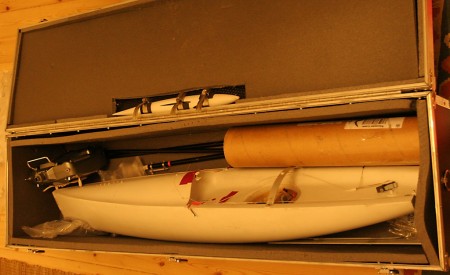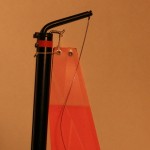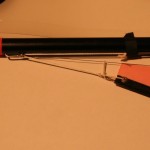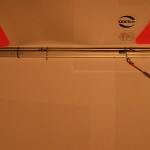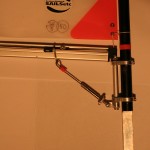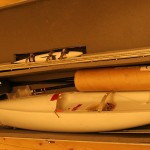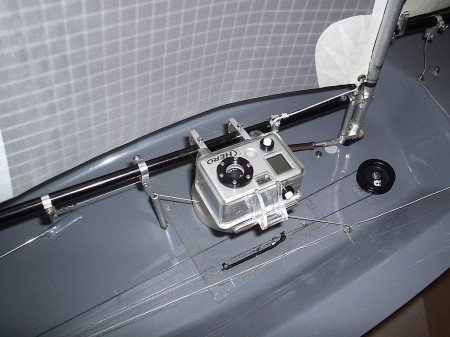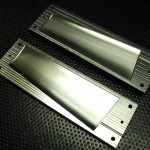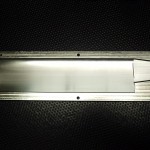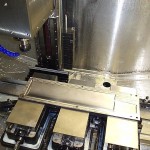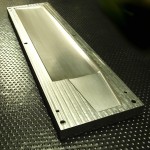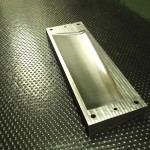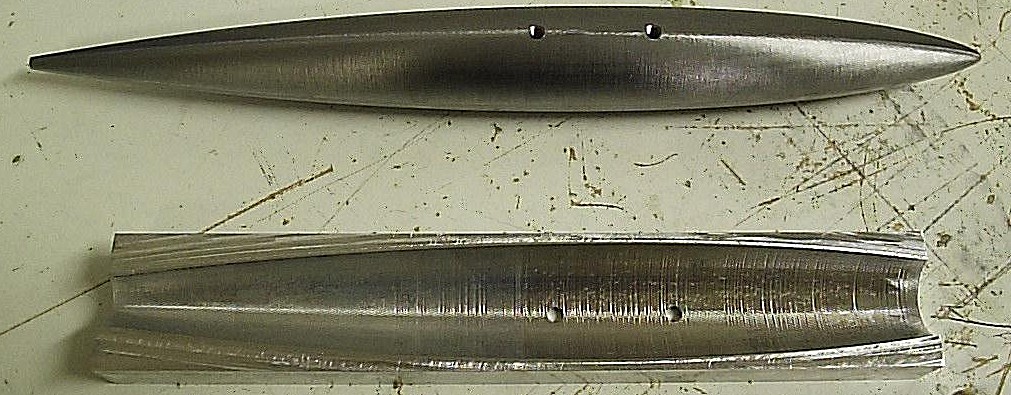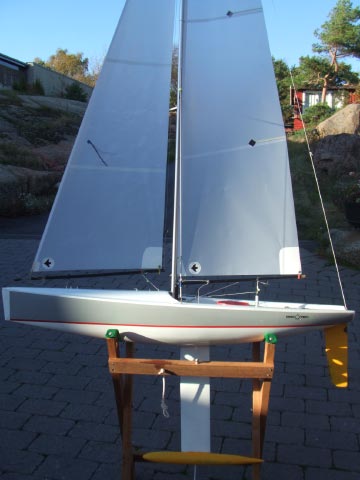Category: IOM Building
More plug milling
The model yacht plug we're making is milled in three stages. First a rough-cut, then a finish-cut which cuts the plug 1 mm undersize. Then it's coated with a thick layer of tooling gelcoat. What you see above is the final milling pass where the gelcoat is cut down to the final shape. This way we're hoping the final plug will require a minimum of painting/sanding before use.
Lester Gilbert has some new Pikanto pictures on his site. Eventually this project will produce boats like that, but with a deck which is simpler to mould, and with a process we hope to streamline as much as possible.
Milling MDF
Jari is making plugs for our latest IOM-project, and he posted two new videos:
Rough milling:
Finish milling:
The 1000 mm long hull plug will be made from a left and a right half, and each half consists of three parts. This is the first part from the bow to around 300mm.
Wave goodbye, wish me well
FIN-43, my current Noux-design IOM, is packed and ready for shipping to its new owner next week. I made a holder for the bulb from tube-clamps, and disassmbled the rigs today. Everything fits nicely into my 110x30x26 cm boat box.
The plan for 2009 is to cnc-mill plugs and make moulds for a variant of Pikanto, Graham Bantock's latest design. It's important to use time and effort on good design and good moulds. I want the boat and the components to come out of the moulds almost ready to use. Keep it simple stupid. CAD-design time and time on the cnc-mill is cheap, hours spent moulding and hand-building are expensive (for me anyway). More about that later. It also looks like we will be milling a new set of bulb, fin, and rudder moulds in December-January. We're happy to mill moulds for other people too, but most people don't answer the second email where I tell them a fin-mould costs 500 euros (which we think is reasonable).
IOM Sail Camera
Jari got a Hero camera which takes still pictures and video and stores them on a memory card. It weighs about 120g and it's watertight, so it's possible to put it on-board and take some pictures while sailing. Seems to work quite well. This could be used later for looking at how the mast bends in different winds and with different shroud and/or spreader positions. (See here for some statistics from the ongoing IOM Euros).
IOM fin and rudder moulds
With the servo-upgrade of the cnc-mill complete we are now beginning to run the kind of jobs that weren't previously possible. Stepper motors simply don't give the kind of 3D contouring capability and reliability for running 3-4 hour finish jobs like these. The finmould is finished with a 6 mm ball-nose cutter.
Jari made these moulds in steel, but it's possible to cut them in aluminium too. The fin mould here has a NACA 0010 section and the rudder has a thicker NACA 0015 section. With the precision that cnc-cutting provides we hope that the fin can come out of the mould quite complete and fit a cnc-cut finbox/bulb without much manual fitting.
We can produce fin, rudder, and bulb moulds in steel or aluminium on a small scale. Get in touch by email or by commenting below if you are an interested IOM-builder.
Steel Bulb nr2
After the test run on Saturday Jari made a complete bulb in steel on Sunday. The first half can be milled with the stock clamped to the vises, but for the second half we need this jig. It's in aluminium and was fairly simple to make - which also means making a bulb mould in aluminium should be easy. If someone is interested in a bulb mould, do drop me an email.
Milling the second half proceeds exactly like the first half. Here the rough-program is run leaving about 1 mm minimum of material for the finish pass. We now adjusted the program for a bit faster feedrate and much faster plunge-rates as it is clear the program is error free and all plunges are outside the stock.
Surface finish is slightly better than on the trial bulb. The design weight was 2410 g and this one came out at 2416 g - pretty good. With a 100-150 g fin trimming the total weight close to 2500 g shouldn't be a problem.
Widgets for Sail
Graham Elliot from the UK doesn't have a website of his own (yet?) , but wanted to let everyone know that he is now building and selling the Widget IOM. Designed by Chris Dicks in 1995 the boat has gone through quite a few changes to everything except the hull shape. The Widget has won the 1996 European Championship, the British National championships in 1997 and 2007, and the 2007 World Championship, not bad for a boat that was designed 13 years ago. The mouldings of the boat are manufactured by Dave Creed.
Graham's options and prices are:
- Boat complete to deck level, including cf fin and rudder, all attachment points, pulleys, adjustable main post, keel, all finished = 840 euro.
- RMG 280D, 42mm drum, thumbscrew, fitted in boat=215 euro.
- Rudder Servo, hitec 645 ultra torque, fitted in boat=75 euro.
- Rigs: prices vary depending on which fittings (sails etc or housemartin) and also which sails are preferred (housemartin , Brad Gibson , Stealth , sails etc)
- Wooden rig box= 80 euro
- 4 colours: red, orange, blue, grey. They are all sprayed using Epifanes 2 pot polyurethane paint.
Currently (Feb 2008) there is a waiting list of approximately 16-18 weeks.
Please contact Graham Elliot on elliottyachts "at" hotmail.co.uk if you are interested!
Wireless Mast Camera
Jari got a small wireless camera operating on 2.4 GHz and mounted it at the top of the mast on his no2 rig. With the bulky power connector removed and a longer wire for the 9V battery which is under the deck the camera weighs about 20g. Now we used a preliminary aluminium angle to hold the camera, but a better carbon arm should be made for next summer.
This camera is the variant where you can plug the receiver straight into a laptop via the USB port. The receiver even gets its power via USB, so no extra power supplies needed in the field. Range seemed good, and image quality was OK - probably now limited more by the compression used in the PC than by the camera.
The idea is to look at how the sails, mast, and whole rig behaves from on-board images. It's probably hard to say something from a single video or frame, but if some parameters (say shroud height) is systematically varied on the same boat in the same conditions then we're hoping this could provide some insight into what's going on.
